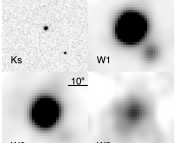Title: SDSS J184037.78+642312.3: The First Pulsating Extremely Low Mass White Dwarf
Authors: J. J. Hermes, M. H. Montgomery, D. E. Winget, Warren R. Brown, Mukremin Kilic, Scott J. Kenyon
First Author’s Institution: UT Austin, TX
97% of all stars — those with initial masses less than about 8 solar masses — end their lives as white dwarfs (WDs), hot objects with roughly the mass of the Sun but with the radius of the Earth. They have virtually no internal source of energy and so simply cool with time. Some of the coolest white dwarfs have been around for quite a while and are probes of conditions in the early Universe. They are also tracers of galaxy evolution and can be used to date stellar populations. Understanding their nature is key if we are to use white dwarfs for these purposes.
Asteroseismology of pulsating white dwarfs is one way to learn about the interior structure of these fascinating objects. Asteroseismologists use stellar vibrations in much the same way as seismologists use earthquakes to study Earth’s interior (see this astrobite and this one). The authors of this paper are on a hunt for DAV WDs. For those of us who don’t speak white dwarf lingo, that’s a white dwarf (“D”) with a hydrogen atmosphere (the “A” subclass) that pulsates (“V” for variable). There are actually quite a few of these DAV WDs, but the 150 we know of are fairly massive for white dwarfs, with masses between 0.5 and 1.1 solar, and are believed to have carbon-oxygen cores. These authors are after a rarer beast: a pulsating helium-core white dwarf, which would have a lower mass.
Helium-core white dwarfs pose a bit of a mystery, which is why the authors are so keen on finding one. To form one, mass needs to be driven from a red giant star, halting further fusion in its core. In one theory, the progenitor star loses mass to its binary companion after it enters the red giant stage; but in this case He-core white dwarfs should be found in binaries — yet we see isolated examples. In a second theory, strong stellar winds drive mass loss, though there’s little observational evidence so far. But, this scenario can’t produce the lowest-mass He-core white dwarfs.
In this discovery paper, Hermes et al. present observations of the first pulsating extremely low mass white dwarf, given the inventive nickname J1840. It was discovered very recently (Brown et al, 2012) and has a mass of just 0.17 solar masses. This find comes along with twenty non-detections of pulsations (presented both in this paper and in Steinfadt et al., 2012). Interestingly, J1840 has an unseen companion, which is likely also a white dwarf. J1840 was observed over three consecutive nights at high precision, shown in the figure below. Because the object is setting (that is, it is only up at the tail end of the night), only a total of five and half hours of data could be collected. This makes an asteroseismic investigation impossible at present, but variability, a result of the white dwarf’s pulsations, is clearly seen.
The authors are hopeful that further observations and analysis will help us to understand this object. What drives its pulsations? Is it the same mechanism that drives carbon-oxygen core pulsators, or something different? What does asteroseismology tell us about its interior? And can we find more like it?

This figure shows the photometry for J1840 over three consecutive nights (divided into three panels). The time covered is short, because the star is about to go behind the Sun and leave the night sky! But, its variability is clearly detected. The variability is not completely periodic, however: the patterns don't quite match up over the three nights. Figure 1 from the paper.




